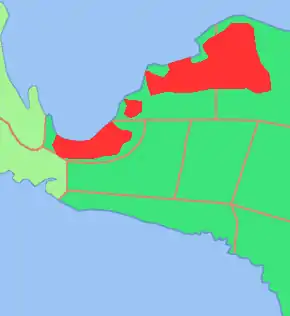| East Geelvink Bay | |
|---|---|
| East Cenderawasih | |
| Geographic distribution | Papua Province, Indonesia |
| Linguistic classification | One of the world's primary language families |
| Glottolog | geel1240 |
 | |
The East Geelvink Bay or East Cenderawasih languages are a language family of a dozen Papuan languages along the eastern coast of Geelvink Bay in Indonesian Papua, which is also known as Sarera Bay or Cenderawasih.
Languages
- East Geelvink Bay
- Turunggare, Burate
- Barapasi
- Bauzi–Demisa, Nisa-Anasi (Bapu)
- Central
Of these, only Turunggare, Barapasi, and Bauzi are known well enough to demonstrate a relationship, though they are all lexically similar (> 60%). The unclassified Kehu language, spoken between Turunggare and Burate, may turn out to be East Geelvink Bay as well.
Bauzi is the best documented East Geelvink Bay language, but may or may not be representative of the Geelvink Bay family as a whole.[1]
Classification
A relationship between Yawa, spoken on Yapen Island, and the East Geelvink Bay languages was tentatively proposed by C. L. Voorhoeve in 1975 in a proposal he called Geelvink Bay. The hypothesis was taken up by Stephen Wurm, who developed it as part of an initial attempt to classify the Papuan languages; however, the relationship would be a distant one, and later linguists such as Mark Donohue considered Yawa to be a language isolate.
Clouse (1997)[2] removed the Lakes Plain languages of the upper Mamberamo River in the interior of Papua from Trans–New Guinea, where Würm had placed them, and by comparison with Bauzi and Demisa proposes them to be a sister family of the East Geelvink Bay languages. Basic vocabulary cognates that Clouse suggests to connect the two stocks include:
| meaning | Proto-Lakes Plain | Bauzi | Demisa |
|---|---|---|---|
| 'eye' | *kudatiCV | (faxo) | halukwa |
| 'muscle' | *tV | nubu | (betinukwa) |
| 'water' | *deida | vaɔ | wɔte |
| 'fire' | *kudaide | vua | gwa |
| 'tree' | *kuCV | uto | |
| 'black' | *kVCa | gihot | giho |
| 'child' | *tau-bri | data | dataβi |
| 'we' | *ai | i | |
| 'go, walk' | *kidia | la | |
| 'blow' | *pudV | fɛu | |
| 'feces' | *pade | haɛ | |
| 'arrow' | *poka | fɔ | |
| 'bad' | Proto-Tariku: *ɸVra | fait |
However, in his 2005 classification based on comparative evidence from pronouns, Malcolm Ross treats all three groups as separate families, with Yawa tentatively placed in an extended West Papuan family.
Typology
Verbal morphology in the East Geelvink Bay family is less complex than that of Tor-Kwerba languages, but is more complex than that of the Lakes Plain languages.[1]
Pronouns
The pronouns Ross reconstructs for proto–East Geelvink Bay are,
I *e we *i thou *o you *u s/he *a they ?
Basic vocabulary
Basic vocabulary of selected East Cenderawasih languages (Barapasi, Bauzi, Demisa, Tunggare) listed in Foley (2018):[1]
East Cenderawasih family basic vocabulary gloss Barapasi Bauzi Demisa Tunggare ‘bird’ de bume bijana dinarate ‘blood’ nosi vasɛa nahabi nahavei ‘bone’ para fa heta ha ‘eat’ ai æ ɣayo ‘egg’ moʔa ɔɔ mwa ʔoʔo ‘eye’ aronua faxo halukwa hanua ‘fire’ awa vua gwa urehe ‘give’ wai lɔ nore ‘ground’ deta bake bæi baʔe ‘hair’ nawa ohuta ohutai ohitaʔi ‘head’ osi ohula ohuda ʔohaha ‘I’ emi e emdə ei ‘leg’ naro naɔ naro nal ‘louse’ woa vɔa yo ʔua ‘man’ doro dam damateha date ‘name’ here ɛ ʔe ‘one’ orari væmtɛa natudüe duaʔa ‘see’ ute aa maʔai ‘stone’ aea kɛ ɛdu hahia ‘sun’ wapao ala arɔ au ‘tooth’ moru mo molu mou ‘tree’ auma uto uto-me ‘two’ apimi bɛhæsu utahu amaite ‘water’ waro vaɔ wɔte mana ‘we’ i-me i i ‘you (pl)’ u-mi u wi
The following basic vocabulary words are from Clouse (1997)[2] and Voorhoeve (1975),[3] as cited in the Trans-New Guinea database:[4]
gloss Bauzi Demisa Barapasi Tunggare head dauha; ohula ohuda osi ʔohaha hair ohuta ohutai nəwa ohitaʔi ear dogoi hema eye fako; faxo halukwa aronua hanua nose ɔmtɔ omata tooth mõ moru mou tongue iso itsa leg nabaː; nao naɾo naro nal louse vɔa; vwa yo woa ʔua dog vɛm; veme nimi weme pig doho; dɔhɔ beiji doho bird bume; bumɛ bijana de dinarate egg ʔo; ɔɔ mwa moʔa ʔoʔo blood vasɛa; veiso nahabi nosi nahavei bone fa; oveha heta para ha skin sogoba; sɔkɔba hiɔ terebaʔa isaʔa breast ahudɛ ubɾa tree uto auma uto-me man data doro date sky asum asunawa sun ala; ala(meoho) aɾɔ wapao au moon ala aɾo water valo; vaɔ wɔte waro mana fire üwa; vua gwa awa urehe stone kɛ; khe ɛdu aea hahia name ɛ; ele here ʔe eat æ; udeʔa aire ghayo one væmtɛa; vamtia natudüe orari duaʔa two beasu; bɛhæsu utahu apimi amaite
See also
- Papuan languages
- Districts of Papua for a list of districts and villages with respective languages
References
- 1 2 3 Foley, William A. (2018). "The languages of Northwest New Guinea". In Palmer, Bill (ed.). The Languages and Linguistics of the New Guinea Area: A Comprehensive Guide. The World of Linguistics. Vol. 4. Berlin: De Gruyter Mouton. pp. 433–568. ISBN 978-3-11-028642-7.
- 1 2 Clouse, Duane A. (1997). "Towards a reconstruction and reclassification of the Lakes Plain languages of Irian Jaya". In Karl Franklin (ed.). Papers in Papuan linguistics no. 2 (PDF). Vol. A-85. Canberra: Pacific Linguistics. pp. 133–236. ISBN 0858834421.
- ↑ Voorhoeve, C.L. Languages of Irian Jaya: Checklist. Preliminary classification, language maps, wordlists. B-31, iv + 133 pages. Pacific Linguistics, The Australian National University, 1975. doi:10.15144/PL-B31
- ↑ Greenhill, Simon (2016). "TransNewGuinea.org - database of the languages of New Guinea". Retrieved 2020-11-05.
- Ross, Malcolm (2005). "Pronouns as a preliminary diagnostic for grouping Papuan languages". In Andrew Pawley; Robert Attenborough; Robin Hide; Jack Golson (eds.). Papuan pasts: cultural, linguistic and biological histories of Papuan-speaking peoples. Canberra: Pacific Linguistics. pp. 15–66. ISBN 0858835622. OCLC 67292782.